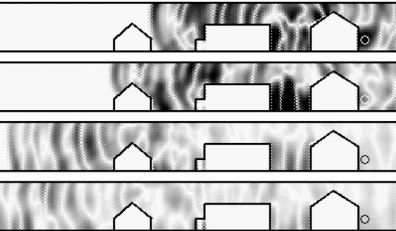Acoustic Pulse Propagation in an Urban Environment
using an
three-dimensional Numerical Simulation
Ravish Mehra1
Nikunj Raghuvanshi2
Anish Chandak1
Donald G. Albert3
D. Keith Wilson3
Dinesh Manocha1
1University of North Carolina at Chapel Hill 2Microsoft Research 3U.S. Army Cold Regions Research and Engg. Lab

| 
|
Abstract
Acoustic pulse propagation in outdoor urban environments is a physically complex phenomenon due to the predominance of reflection, diffraction, and scattering. This is especially true in non-line-of-sight cases, where edge diffraction and high-order scattering are major components of acoustic energy transport. Past work by Albert and Liu [J. Acoust. Soc. Am. 127, 1335–1346 (2010)] has shown that many of these effects can be captured using a two-dimensional finite-difference time-domain method, which was compared to the measured data recorded in an army training village. In this paper, a full three-dimensional analysis of acoustic pulse propagation is presented. This analysis is enabled by the adaptive rectangular decomposition method by Raghuvanshi, Narain and Lin [IEEE Trans. Visual. Comput. Graphics 15, 789–801 (2009)], which models sound propagation in the same scene in three dimensions. The simulation is run at a much higher usable bandwidth (nearly 450 Hz) and took only a few minutes on a desktop computer. It is shown that a three-dimensional solution provides better agreement with measured data than two-dimensional modeling, especially in cases where propagation over rooftops is important. In general, the predicted acoustic responses match well with measured results for the source/sensor locations.
Ravish Mehra, Nikunj Raghuvanshi, Anish Chandak, Donal G. Albert, D. Keith Wilson and Dinesh Manocha. Acoustic Pulse Propagation in an Urban Environment using an three-dimensional Numerical Simulation , in the Journal of Acoustical Society of America, 2014.
Preprint (PDF, 2.1 MB) Journal link
Acknowledgement
This research was supported in part by the Link Foundation Fellowship in Advanced Simulation and Training, ARO Contracts W911NF-10-1-0506, W911NF-12- 1-0430, W911NF-13-C-0037, and the National Science Foundation (NSF awards 0917040, 1320644). Additional funding for this research was provided by the U.S. Army Engineer Research and Development Center’s Geospatial Research and Engineering business area.